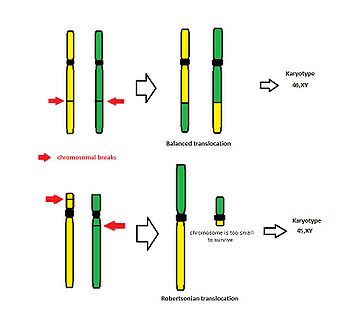Translocation
From WikiLectures
Translocation is a form of structural abnormality of the chromosomes.
- During translocation, a part of one chromosome is transfered to another chromosome.
- It is very important whether the translocation is balanced or unbalanced. Balanced means that two chromosomes just exchange their parts but the number of chromosomes stays the same (46 chromosomes).
- Fortunately – typical place of break is near the centromere, usually only small arms of the acrocentric chromosomes are lost. There are no crucially important genes coded by these chromosomal segments. So, a carrier of such Robertsonian translocation can normally survive this cytogenetic change.
- Unfortunately the problems occur during the fertilization. Carrier of the translocation may produce unbalanced gametes, beacause the process of homologous chromosomes pairing during meiosis is interrupted. This is very important because unbalanced gametes lead to abnormalities in offspring. The reason is that the offspring receives altered chromosome from the carrier which may lack several important genes.
- Therefore the only clinical symptom found in the carriers of balanced translocations may be the reproduction failure.
Types of translocation[edit | edit source]
- Reciprocal – translocation between two chromosomes ("A segment" goes to "B chromosome" and "B segment" goes to "A chromosome").
- Robertsonian – translocation (or fusion) of two acrocentric chromosomes.
Links[edit | edit source]
Related articles[edit | edit source]
Bibliography[edit | edit source]
- KUMAR, ABBAS, FAUSTO, MITCHELL,, et al. Robbins Basic Pathology. 8th edition edition. 2007. ISBN 978-0-8089-2366-4.

